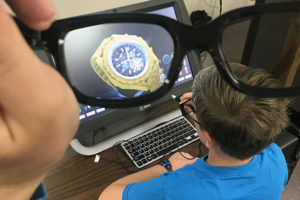
Students test their balloon cars and collect data in order to use Python to calculate the average speed and plot the results to find out who had the fastest car.
NE Senior Matthew Herald Shares Passion for STEM to Reach the Next Generation of Rural Students
These days, more people on the planet use a mobile phone than a toothbrush, according to the Smithsonian Science Education Center, yet millions of STEM jobs go unfilled in a growing industry because there simply aren’t enough workers to meet the demand.
UT nuclear engineering senior Matthew Herald, who hails from the small town of London, Kentucky, gained exposure to nuclear engineering through high school, and that helped him feel confident the major would be a good fit. He ultimately chose UT for its highly ranked program and proximity to Oak Ridge National Laboratory.
Through minoring in engineering entrepreneurship, he heard about an internship program with the Knoxville Entrepreneur Center (KEC). As a self-starter who enjoys writing his own computer code, he decided to apply and was accepted.
Rather than work with a start-up company, he chose to create a summer project of his own design in order to share the wonders of scientific exploration with young students who shared a similar background to his own. He proposed the idea of STEM outreach for rural communities, and his computer science skills helped seal the deal.
—Matthew Herald
The project became a 10-week camp with local middle schoolers focused on computer science and coding. KEC provided funding as well as program management and an additional intern.
Each week, they traveled to a new group of students organized through community and education connections. The first two days covered the basics of programming in Python and Arduino. Mid-week, students coded and worked on individual creative projects. On Friday, they would finalize projects and showcase their work to parents during the closing ceremony.
“Most of the schools we reached out to were rural, small, and didn’t have a large tech exposure,” said Herald. “This was similar to how I grew up in Kentucky; there were no coding classes or many opportunities to learn about tech. Providing this opportunity to these students was important for me to encourage their curiosity and willingness to follow their interests in a creative way.”
Herald believes the program had successful outcomes, with many participants expressing gratitude to be able to explore their interests. One kid in particular stood out:
“He was really interested in Marvel comics and drawing the characters,” recalled Herald. “For his creative project he drew a cutout of a character, attached it to a small motherboard controlled by a joy stick, and made flashing LED lights for the eyes. I could tell that he was very proud of his creation, and I was happy to teach him.”
Herald continues to encourage other engineering students to explore the path to engineering entrepreneurship as a way to learn what’s possible with advanced STEM skills.
Additional Camp Photos
With the assistance of Walter State Community College, some students were able to experiment with different types of virtual reality.
- A student manipulates a virtual wristwatch using the ZSpace’s touchscreen and pen. To see the object, special glasses must be worn that provide the illusion of 3D.
- The second student is using the HTC Vive to play “The Lab,” a game that showcases new types of experiences for VR users like interacting with objects, traveling to postcard locations, and even shooting arrows with a virtual bow.
Élan Young: elan@tennessee.edu

